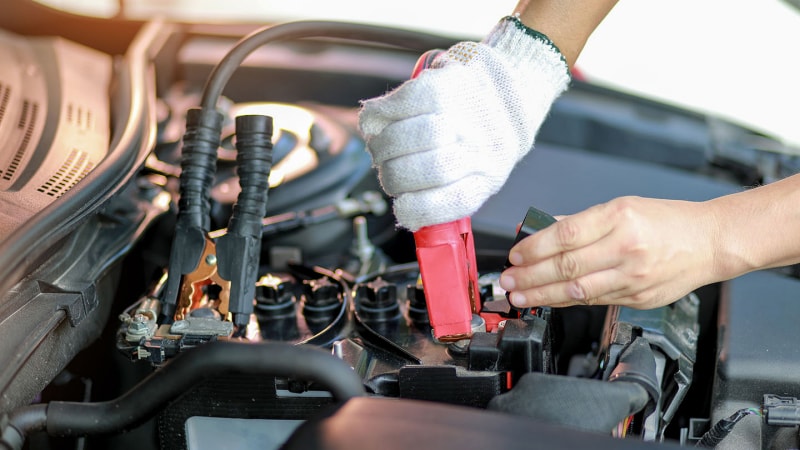How to charge a car battery

Quick insights
- Understanding how to properly charge a standard car battery can extend its life and prevent roadside headaches.
- A standard car battery typically takes anywhere from 4 to 24 hours to fully charge, depending on the type of charger and battery condition.
- It’s important to use a reliable charger and follow the relevant safety guidelines.
Charging your car battery might not be the most electrifying activity, but it's an important skill for any vehicle owner. Keeping your battery in good condition helps to protect you from feeling powerless on the side of the road.
What you need to charge a car battery
To charge a car battery effectively, you'll need the right tools and workspace. This includes the following:
- A compatible battery charger: Not all chargers are suitable for all types of car batteries. It's important to use a charger that's compatible with your specific battery type in order to charge effectively and prevent potential damage.
- Safety gear: Charging a car battery can involve risks, such as acid spills or sparks. Wearing safety gear like gloves and goggles can help protect you from these hazards.
- A well-ventilated area to work in: Car batteries can emit harmful gases during the charging process. Working in a well-ventilated area can help disperse these gases and reduce the risk of inhalation or combustion.
- Clean cloths and a wire brush for cleaning battery terminals: Over time, battery terminals can become corroded, which can hinder the charging process. Using clean cloths and a wire brush to clean the terminals can help ensure a good connection and more efficient charging.
These items can help you acheive a safe and efficient charging process.
How to charge a car battery with a battery charger
Recharging a car battery is a straightforward process, but it can be helpful to follow these steps:
- Check the battery: Inspect the battery for signs of damage or corrosion. Clean the terminals with a wire brush to help prevent any charging issues.
- Connect the charger: Most chargers use the same colors — red for positive and black for negative. Attach the red clamp to the positive terminal and the black clamp to the negative terminal. Make sure the connections are secure to avoid any sparks or poor charging.
- Set the charger: Identify your car battery's voltage in your car’s user manual or on the battery itself. It is usually 12 volts, but can sometimes be 6 for older vehicles. Then select a suitable amperage on your charger. Lower amperage is safer but slower. Always refer to your battery and charger instructions for correct settings. Doing so can help provide the right amount of power for efficient charging.
- Monitor the process: Most chargers have indicators (like a light or gauge) that show when the battery is fully charged. Keep an eye on the progress and disconnect the charger once the indicator signals completion. This will prevent overcharging, which can harm the battery's lifespan and performance.
How long does it take to charge a car battery?
The charging time for a car battery can vary. A typical 12-volt car battery, when charged with a standard charger, can take anywhere from 4 to 24 hours to fully charge. Factors that affect charging time include the battery’s capacity, its initial state of charge and the effectiveness of the charger being used.
Can you charge a car battery without a charger?
While it's best to use a charger, you can temporarily charge a battery without one by using jumper cables connected to another car’s battery or by using a portable jump starter. Solar chargers are also an option for trickle charging. Trickle charging is a slow, continuous charge that keeps a battery topped up over time.
Solar chargers are an eco-friendly option for trickle charging, but they depend on sunlight availability and often take longer than a standard charger to fully charge a battery.
How to tell if a car battery is dead
Determining if a car battery is dead can be completed with a few checks:
- Check the response: Turn on the ignition and see if the engine cranks. If it doesn’t, or if it cranks very slowly, the battery might be dead or very low. A healthy battery should start the engine promptly.
- Inspect the lights: Dim headlights and dim dashboard lights are signs of low battery power. If the lights brighten when the engine is first started, this indicates the battery is not holding a charge well.
- Use a multimeter: A multimeter can measure the voltage level of the battery. Typically, a healthy car battery should have a voltage from 12.4 to 12.7 volts when fully charged. If the reading is below 12 volts, it's likely that the battery is faulty or discharged.
- Listen for clicking sounds: When starting the vehicle, listen for a clicking sound. This can indicate that the battery is too weak to turn the engine over.
- Check for sulfation: Sulfation, indicated by white or grayish powder on the battery terminals, is a buildup of lead sulfate crystals. Sulfation can prevent a battery from holding a charge and is often a sign the battery needs replacing or serious maintenance.
The bottom line
Properly charging your car battery is key to maintaining your vehicle’s reliability. With the proper tools and preparation, you can help extend your battery life. Remember, a well-charged battery keeps you in the driver’s seat of car care.



